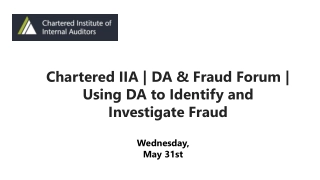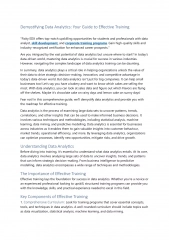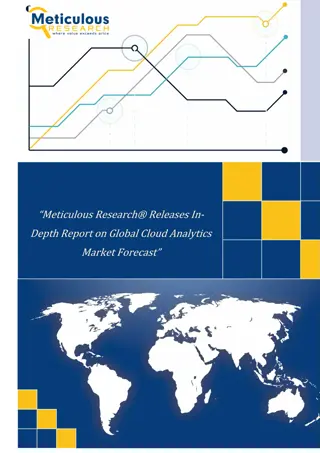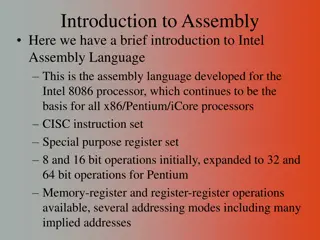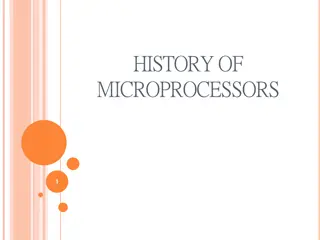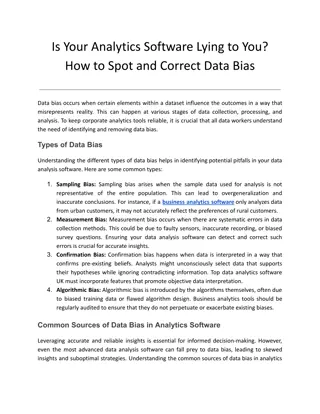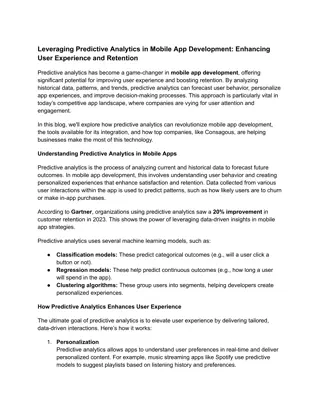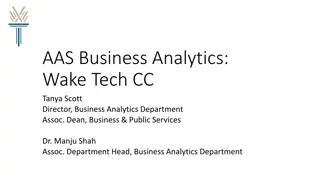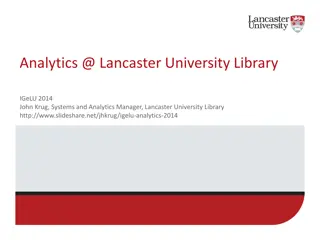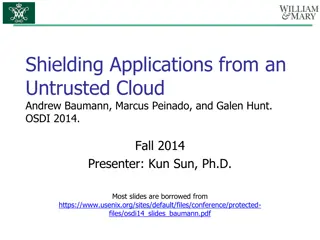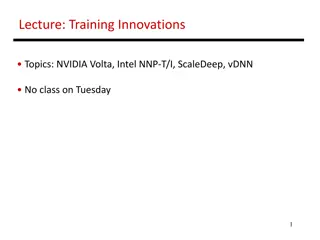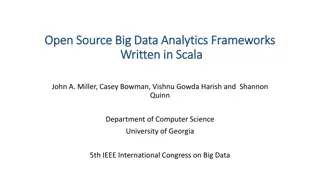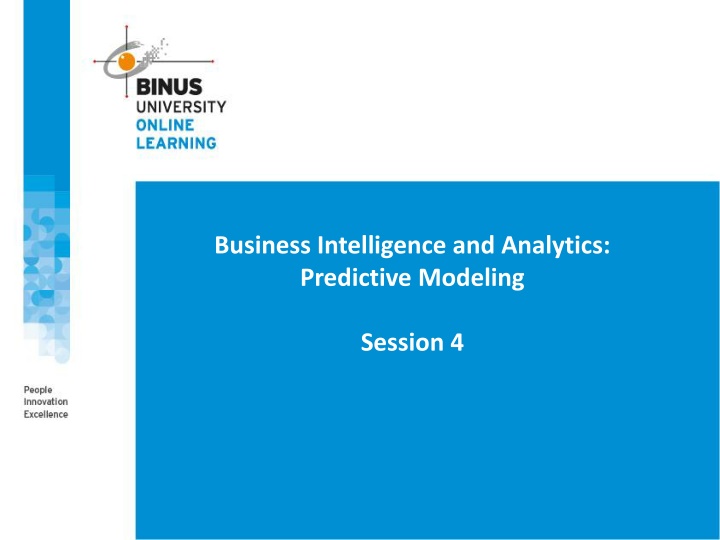
Predictive Modeling Techniques for Business Intelligence and Analytics
Explore the fundamentals of predictive modeling in Business Intelligence and Analytics, focusing on supervised segmentation and attribute selection. Understand the importance of creating predictive models and refining data mining processes for better insights and decision-making.
Download Presentation

Please find below an Image/Link to download the presentation.
The content on the website is provided AS IS for your information and personal use only. It may not be sold, licensed, or shared on other websites without obtaining consent from the author. If you encounter any issues during the download, it is possible that the publisher has removed the file from their server.
You are allowed to download the files provided on this website for personal or commercial use, subject to the condition that they are used lawfully. All files are the property of their respective owners.
The content on the website is provided AS IS for your information and personal use only. It may not be sold, licensed, or shared on other websites without obtaining consent from the author.
E N D
Presentation Transcript
Business Intelligence and Analytics: Predictive Modeling Session 4
CRISP-DM Cross Industry Standard Process for Data Mining Iteration as a rule Process of data exploration
Introduction Fundamental concept of DM: predictive modeling Supervised segmentation: how can we segment the population with respect to something that we would like to predict or estimate Which customers are likely to leave the company when their contracts expire? Which potential customers are likely not to pay off their account balances? Technique: find or select important, informative variables / attributes of the entities w.r.t. a target Is there one or more other variables that reduces our uncertainty about the value of the target? Select informative subsets in large databases
Agenda Models and induction Attribute selection Decision Trees Probability Estimation
Models and induction A model is a simplified representation of reality created toserve a purpose A predictive model is a formula for estimating the unknown value of interest: the target Classification/class-probab. estim. and regression models Prediction = estimate an unknown value Credit scoring, spam filtering, fraud detection Descriptive modeling: gain insight into theunderlying phenomenon or process
Terminology (1/2) Supervised learning Model creation where the model describes a relationship between a set of selected variables (attributes/features) and a predefined variable (target) The model estimates the value of the target variable as a function of the features Induction Creation of models from data Refers to generalizing from specific case to general rules How can we select one or more attributes/features/ variables that will best divide the sample w.r.t. our target variable of interest?
Agenda Models and induction Attribute selection Decision Trees Probability Estimation
Supervised segmentation Intuitive approach Segment the population into subgroups that have different values for the target variable (and within the subgroup the instances have similar values for the target variable) Segmentation may provide a human-understandable set of segmentation patterns (e.g., Middle-aged professionals who reside in New York City on average have a churn rate of 5% ) How can we (automatically) judge whether a variable contains important information about the target variable? What variable gives us the most information about the future churn rate of the population? 10
Purity, entropy, and information Consider a binary (two class) classification problem Binary target variable: { Yes , No } Attributes: head-shape, body-shape, body-color Which of the attributes would be the best to segment these people in groups such that write-offs will be distinguished from non-write-offs? Resulting groups should be as pure as possible!
Reduce impurity Attributes rarely split a group perfectly Consider if the second person were not there then, body-color=black would create a pure segment where all individuals have (write-off=no) The condition body-color=black only splits off one single data point into the pure subset. Is this better than a split that does not produce any pure subset, but reduces the impurity more broadly? Not all attributes are binary. How do we compare the splitting into two groups with splitting into more groups? Some attributes take on numeric values. How should we think about creating supervised segmentations using numeric attributes? Purity measure information gain / entropy
Entropy (1/2) Measure information gain based on entropy (Shannon) Entropy is a measure of disorder that can be applied to a set Disorder corresponds to how mixed (impure) a segment is w.r.t. the properties of interest (values of target var.) A mixed segment with lots of write-offs and lots of non- write-offs would have high entropy
Entropy (2/2) Entropy measures the general disorder of a set, ranging from zero at minimum disorder (the set has members all with the same, single property) to one at maximal disorder (the properties are equally mixed) Example for one subset Consider a set ? of ten people with seven of the non-write-off class and three of the write-off class
Information gain Information gain (IG) Idea: measure how much an attribute improves (decreases) entropy over the whole segmentation it creates IG measures the change in entropy due to any amount of new information added How much purer are the children c (split set) compared to their parent (original set)?
Information gain Example 1 Two-class problem ( and ) Entropy parent: Entropy left child: Entropy right child: IG:
Information gain Example 2 Same example, but different candidate split attribute here: residence entropy and information gain computations: The residence variable does have a positive information gain, but it is lower than that of balance.
Information gain for numeric attributes Discretize numeric attributes by split points How to choose the split points that provide the highest information gain? Segmentation for regression problems Information gain is not the right measure We need a measure of purity for numeric values Look at reduction of VARIANCE To create the best segmentation given a numeric target, we might choose the one that produces the best weighted average variance reduction
Agenda Models and induction Attribute selection Decision Trees Probability Estimation
Decision Trees If we select multiple attributes each giving some information gain, it s not clear how to put them together decision trees The tree creates a segmentation of the data Each node in the tree contains a test of an attribute Each path eventually terminates at a leaf Each leaf corresponds to a segment, and the attributes and values along the path give the characteristics Each leaf contains a value for the target variable Decision trees are often used as predictive models 20
How to build a decision tree (1/3) Manually build the tree based on expert knowledge very time-consuming trees are sometimes corrupt (redundancy, contradictions, non-completenes, inefficient) DECISION TREE EXPERT INDUCTION Build the tree automatically by induction recursively partition the instances based on their attributes (divide-and-conquer) easy to understand relatively efficient DWH GENERATED ELEMENTARY RULES SAMPLE ELEMENTARY RULES heuristic enumerative heuristic enumerative
How to build a decision tree (2/3) Recursively apply attribute selection to find the best attribute to partition the data set The goal at each step is to select an attribute to partition the current group into subgroups that are as pure as possible w.r.t. the target variable
ID3 an algorithm for tree induction (1/2) Iterative Dichotomiser (ID3) is the most used machine learning algorithm in scientific literature and in commercial systems Invented by Ross Quinlan in the early 1980s Uses information gain as a measure for the quality of partitioning Requires categorical variables Has no features of handling noise Has no features of avoiding overfitting
ID3 an algorithm for tree induction (2/2) ID3 encompasses a top-down decision tree building process Basic step: split sets into disjoint subsets, where all the individuals within a subset show the same value for a selected attribute One attribute for testing is selected at the current node Testing separates the set into partitions For each partition, a subtree is built Subtree-building is terminated if all the samples in one partition belong to the same class Labels the tree leaves with the corresponding class
ID3: algorithmic structure An intelligent order of the tests is the key feature of the ID3 algorithm ( information gain) Recursive algorithmic structure of ID3: FUNCTION induce_tree(sample_set, attributes) BEGIN IF (all the individuals from sample_set belong to the same class) RETURN (leave bearing the corresponding class label) ELSEIF (attributes is empty) RETURN (leave bearing a label of all the classes present in sample_set) ELSE select an attribute X_j (SCORE FUNCTION) make X_j the root of the current tree delete X_j from attributes FOR EACH (value V of X_j) construct a branch, labeled V V_partition = sample individuals for which X_j == V induce_tree(V_partition, attributes) END
ID3: example steps INCOME INCOME INCOME 15 35 k 15 35 k CREDIT RATING high risk {5, 6, 8, 9, 10, 13} {1, 4, 7, 11} {2, 3, 12, 14} {5, 6, 8, 9, 10, 13} bad {2, 3} {14} {12}
ID3: simplicity ID3 tries to build a tree classifying all the training samples correctly and providing a high probability for implying only a small number of tests when classifying an individual Occam s razor: the simplest tree produces the smallest classification error rates, when applying the tree to new individuals Criterion for attribute selection: prefer attributes which contribute a bigger amount of information to the classification of an individual Information content is measured according to entropy
Agenda Models and induction Attribute selection Decision Trees Probability Estimation
Probability estimation (1/3) We often need a more informative prediction than just a classification E.g. allocate your budget to the instances with the highest expected loss More sophisticated decision-making process Classification may oversimplify the problem E.g. if all segments have a probability of <0.5 for write-off, every leaf will be labeled not write-off We would like each segment (leaf) to be assigned an estimate of the probability of membership in the different classes Probability estimation tree 30
Example - The Churn Problem (1/3) Solve the churn problem by tree induction Historical data set of 20,000 customers Each customer either had stayed with the company or left Customers are described by the following variables: We want to use this data to predict which new customers are going to churn.
The Churn Problem (2/3) How good are each of these variables individually? Measure the information gain of each variable Compute information gain for each variable independently
The Churn Problem (3/3) The highest information gain feature (HOUSE) is at the root of the tree. Why is the order of features chosen for the tree different from the ranking? When to stop building the tree? How do we know that this is a good model?
Conclusion In this chapter, we introduced basic concepts of predictive modeling, one of the main tasks of data science, in which a model is built that can estimate the value of a target variable for a new unseen example. In the process, we introduced one of data science s fundamental notions: finding and selecting informative attributes. Selecting informative attributes can be a useful data mining procedure in and of itself. Given a large collection of data, we now can find those variables that correlate with or give us information about another variable of interest. For example, if we gather historical data on which customers have or have not left the company (churned) shortly after their contracts expire, attribute selection can find demographic or account-oriented variables that provide information about the likelihood of customers churning. One basic measure of attribute information is called information gain, which is based on a purity measure called entropy; another is variance reduction. Selecting informative attributes forms the basis of a common modeling technique called tree induction. Tree induction recursively finds informative attributes for subsets of the data. In so doing it segments the space of instances into similar regions. The partitioning is supervised in that it tries to find segments that give increasingly precise information about the quantity to be predicted, the target. The resulting tree-structured model partitions the space of all possible instances into a set of segments with different predicted values for the target. For example, when the target is a binary class variable such as churn versus not churn, or write-off versus not write-off, each leaf of the tree corresponds to a population segment with a different estimated probability of class membership.
References Provost, F.; Fawcett, T.: Data Science for Business; Fundamental Principles of Data Mining and Data- Analytic Thinking. O Reilly, CA 95472, 2013. Steve Williams: Business Intelligence Strategy and Big Data Analytics, Morgan Kaufman Elsevier, 2016 Carlo Vecellis, Business Intelligence, John Wiley & Sons, 2009 Eibe Frank, Mark A. Hall, and Ian H. Witten : The Weka Workbench, M Morgan Kaufman Elsevier, 2016.

